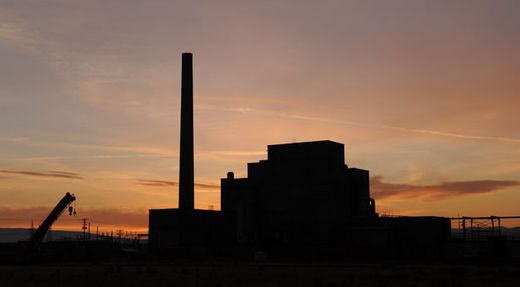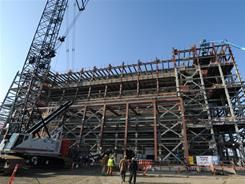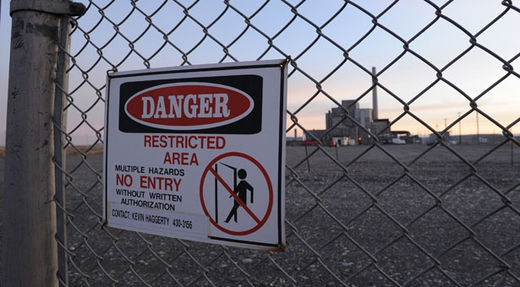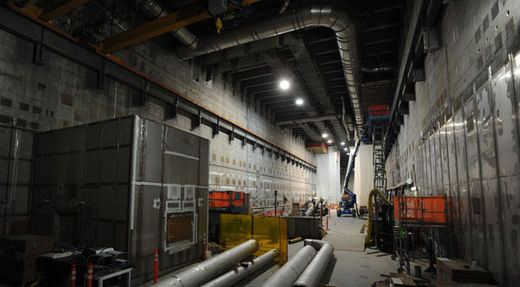
A USA Today investigation has found that the troubled, 10-year effort to build the treatment plant faces enormous problems just as it reaches what was supposed to be its final stage.
In exclusive interviews, several senior engineers cited design problems that could bring the plant's operations to a halt before much of the waste is treated. Their reports have spurred new technical reviews and raised official concerns about the risk of a hydrogen explosion or uncontrolled nuclear reaction inside the plant. Either could damage critical equipment, shut the facility down or, worst case, allow radiation to escape.
The plant's $12.3 billion price tag, already triple original estimates, is well short of what it will cost to address the problems and finish the project. And the plant's start-up date, originally slated for last year and pushed back to its current target of 2019, is likely to slip further.
"We're continuing with a failed design," said Donald Alexander, a senior U.S. government scientist on the project.
"There's a lot of pressure ... from Congress, from the state, from the community to make progress," he added. As a result, "the design processes are cut short, the safety analyses are cut short, and the oversight is cut short. ... We have to stop now and figure out how to do this right, before we move any further."
Documents obtained by USA Today show at least three federal investigations are underway to examine the project, which is funded and supervised by the Department of Energy, owner of Hanford Site. Bechtel National is the prime contractor.
In November, the Energy Department's independent oversight office notified Bechtel that it is investigating "potential nuclear safety non-compliances" in the design and installation of plant systems and components. And the department's inspector general is in the final stages of a separate probe focused on whether Bechtel installed critical equipment that didn't meet quality-control standards.

The "design-build" approach "is good if you're building a McDonald's," said Gene Aloise, the GAO's director of nuclear non-proliferation and security. "It's not good if you're building a one-of-a-kind, high-risk nuclear waste facility."
The Defense Nuclear Facilities Safety Board, an independent federal panel that oversees public health and safety at nuclear weapons sites, is urging Energy Secretary Steven Chu to require more extensive testing of designs for some of the plant's most critical components.
"Design and construction of the project continue despite there being unresolved technical issues, and there is a lot of risk associated with that," said Peter Winokur, the board's chairman. The waste at Hanford, stored in 177 deteriorating underground tanks, "is a real risk to the public and the environment. It is essential that this plant work and work well."
Energy Department officials acknowledged that the design questions are a significant challenge and likely to inflate the project's cost and timetable.
"We've got tough technical issues to deal with," said David Huizenga, acting assistant Energy secretary for environmental management. "Each one of these issues that gets raised, we take it on and we work it until we've solved it. It might take a little longer than we'd hoped and cost a little more ... (but) we will not operate a plant that cannot be operated safely."
Bechtel managers also insisted that all of the plant's designs will be verified before it begins operations. "When complete, the facility will meet all safety and regulatory requirements," communications manager Suzanne Heaston said.
Monumental mess
Everything about the waste treatment plant at Hanford is unprecedented - and urgent.
The volume of waste, its complex mix of highly radioactive and toxic material, the size of the processing facilities - all present technical challenges with no proven solution. The plant is as big as the task: a sprawling, 65-acre compound of four giant buildings, each longer than a football field and as tall as 12 stories high.
The plant will separate the waste's high- and low-level radioactive materials, then blend them with compounds that are superheated to create a molten glass composite - a process called "vitrification." The mix is poured into giant steel cylinders, where it cools to a solid form that is safe and stable for long-term storage - tens of thousands of glass tubes in steel coffins.
Once the plant starts running, it could take 30 years or more to finish its cleanup work.

More than 60 of the tanks are thought to have leaked, losing a million gallons of waste into soil and groundwater. So far, the contamination remains within the boundaries of the barren, 586-square-mile site, but it poses an ongoing threat to the nearby Columbia River, a water source for communities stretching southwest to Portland, Ore. And, while the liquid most likely to escape from the older tanks has been moved to newer, double-walled tanks, the risk of more leaks compounds that threat.
"Each day without progress (in treating the waste) further threatens the Columbia River and its surroundings." Washington Gov. Chris Gregoire warned in November. "There are critical public health and environmental issues at play."
The Bechtel company, under the direction of the Department of Energy, is building this waste treatment plant at Hanford to turn liquid radioactive waste into glass for safer storage.
A 1989 legal agreement among the Energy Department, the U.S. Environmental Protection Agency and the state of Washington sets strict timetables for stabilizing the tank wastes, including a 2011 deadline to get the treatment plant running. Two years ago, a negotiated extension pushed the start-up date to 2019. But a November review by the Energy Department reported that the deadlines are at "significant risk," because of both engineering and budget concerns.
The deadlines "were put in place to ensure the health and safety of the people of Washington and that commitment must continue," Gregoire said, urging that the federal government commit whatever funding is necessary to address the project's technical hurdles and keep it on track. "Falling behind schedule ... is not an option."
Technical difficulties
Most of the technical issues still vexing the project involve moving waste through the plant.
The thicker, high-level waste doesn't flow according to usual laws of physics; it glugs like ketchup spurting from a bottle. The challenge is to keep it moving: If particles in the material accumulate, they can cause clogs, trapping potentially explosive hydrogen gas or, if too much plutonium masses together, triggering an uncontrolled nuclear reaction that generates extreme heat and radioactivity, threatening workers and the plant's operation.
The challenge lies in the plant's huge pre-treatment building, where the waste traverses an intricate set of pipes and vessels as its radioactive streams are separated and sent to separate facilities for conversion into glass. To keep the waste agitated, many of the pre-treatment vessels contain "pulse jet mixers" that act like giant turkey basters, sucking the waste into tubes and expelling it through jet nozzles.
"No one can stand up and say with any certainty that (the mixers) will work," said Walter Tamosaitis, who spent seven years as a supervising engineer on the project for URS Corp. before being reassigned in 2010. During his tenure, he filed memos and reports to top officials questioning the mixers' design.
Some of the high-level waste has turned out to be more complex than anticipated, with plutonium particles up to 10 times larger than expected. That has heightened concerns among several scientists, including Tamosaitis and the staff of the nuclear facilities safety board, that the systems designed to churn that waste need further testing to address the threat of hydrogen buildup or a nuclear reaction.
The mixers will be nearly impossible to repair or modify if they fail, because they will be too radioactive - they're in fortified rooms, known as "black cells," that will be sealed permanently when the plant begins operating. If the system malfunctions, Tamosaitis said, "the plant is dead in the water."
Alexander, the Energy Department scientist, also worries about the pre-treatment mixing system. Because the mixing jets and vessels were not designed to handle the larger plutonium particles and other abrasives in the high-level waste, he said, the material is likely to erode the vessels' lining. Alexander, who has detailed his concerns in official filings, has run simulations showing that the vessels could fail well before the end of the system's 40-year design life, potentially causing a leak inside the plant.
When the jet mixers expel waste into the vessels, they're "like a liquid sandblaster," and the mixing system needs years of extra testing and refinement to account for the problem, Alexander said. "If they don't make any changes and just move ahead, it lasts maybe 10 years."
Tamosaitis and Alexander aren't alone in their concerns.
The mixing system "is not necessarily a solid design," said Donna Busche, a URS employee who serves as manager for environmental and nuclear safety at the site. "The research isn't done, the design isn't done, and there are numerous technical and safety issues ... to address."
Testing on the fly?
The Energy Department has agreed to do more testing of the mixing system's design, but is moving ahead with construction of the vessels before tests are complete. That means the equipment might have to be re-engineered and modified, or replaced entirely, if it fails.
The alternative is to "take the pieces and parts that are sitting in the middle of a vendor's shop and leave them there, not have the vessel completed, while you wait for the results of a large-scale test," said Dale Knutson, the Energy Department's project director. Under the current plan, if the designs pass muster, "you haven't lost the ability to complete the work" on time.
"We would not operate the facility in an unsafe condition," Knutson added. "The question is: Do you have an appropriate hold point in place, a place where you can stop" if the design proves to be inadequate? "In this particular case ... that hold point is defined as prior to installation."
The decision reflects the Energy Department's "design-build" approach: To speed completion, construction occurs while some features still are being designed.
That strategy has fueled a progress-at-all-costs climate that discourages scientists from raising design concerns, said Winokur, the safety board chairman. "The safety culture is flawed."

Last week, a report by the Energy Department's health and safety office echoed many of the safety board's assertions. Assessing the treatment plant project, the report identified "significant concerns" about "processes for nuclear design ... and for managing safety issues."
Busche, the safety manager, said concerns about the potential for hydrogen buildup in components at the pre-treatment facility were pushed aside.
The question is "how likely would an explosion be and would the equipment survive (and) contain the waste?" she said. The safety office raised "significant issues" about the mixing system's design because assumptions on hydrogen buildup were "not conservative enough" to account for all the risks, she added.
In October, after many of the system's components already were being installed, Energy officials warned Bechtel in a letter that some of the piping had not been shown to meet safety requirements, records obtained by USA Today show. In a November response , Bechtel said it had ordered a "suspension of work" on the piping system pending more design review - a move the company described in a statement as a "conservative approach."
Busche shares many of the concerns raised by Tamosaitis, Alexander and the safety board. "We're all coming at these issues in different ways," she said. But when they're raised, "the first question that gets asked is not 'how are we going to solve it?' It's 'how much is it going to cost?' ... I've never seen this sort of flagrant disregard for technical issues."
Project managers said that disagreements over risk and safety assumptions are to be expected on such a complex undertaking, but rejected the notion that concerns aren't taken seriously - or that money drives the response.
It's in everyone's interests to build a plant that works properly and safely, said Richard Kacich, an assistant project director for Bechtel. "The earlier you know about (a safety issue), the earlier you can deal with it. ... The culture of our company is highly supportive of bringing issues forward."
"On a first-of-its-kind project, are there (design) challenges? Of course," he added. But "as with any nuclear undertaking, the way a project delivers is to focus on safety ... and quality."
Explosion in costs
Each challenge requires more work and more time - and more money.
In its November construction report , the Energy Department warned that it's on a path to spend $800 million to $900 million more than the plant's current, $12.3 billion budget. When the project was launched, on what was expected to be a much smaller scale, it was budgeted at about $4 billion.
"I can't give you an exact number or sense of what I think the project is ultimately going to cost," said Huizenga, the assistant Energy secretary, adding that managers are seeking ways to offset the projected cost overruns. He also declined to estimate when the plant might start or finish treating tank waste, though he reiterated that deadlines for both tasks are "at risk."
The overrun figures may be just a hint of what's to come: They don't include major modifications that officials now are contemplating to address some of the technical problems that have emerged.
Because of the complex nature of some of the tank waste, including the larger plutonium particles, Energy Department officials including Huizenga acknowledge that a portion of the material probably will require some sort of preliminary processing before it can be sent into the pre-treatment facility. Potential solutions include reconfiguring the pre-treatment facility or designing and building equipment to filter the waste as it's removed from the tanks.
Any changes would cost money unaccounted for in current budget projections.
"They will need to find alternative ways to treat some of that material," Winokur said. "There will need to be additional investments."
That's not the only problem that would require more spending, he said. He noted, for example, that the treatment plant's current design, which has been modified several times, has the capacity to treat only about 50% of the less complex, low-level radioactive liquid waste that it's supposed to handle.
And no plan has been finalized - or budgeted - for how to process the rest.
Tamosaitis and Alexander said they believe it will take billions of dollars in added funding to complete the project.
Congress already is showing frustration with the plant's escalating cost and engineering problems.
The 2012 appropriations bill that funds the Energy Department directed officials to do a major review of "contract management" for all nuclear facility cleanups with budgets over $1 billion. The study is due in May, according to the bill, and must assess whether practices "foster a positive nuclear safety culture or resolve nuclear safety-related design issues."
Lawmakers also balked at the department's 2012 funding request of $840 million for the project - a 22% increase from the $690 million a year that was projected. Instead, lawmakers agreed to $740 million.
The reduced amount probably is not enough to keep the construction on schedule given the engineering challenges that have emerged, Huizenga said. Still, he added, the project "is an extremely high priority for us," and the department will push ahead until it is complete.
Ultimately, "cost and schedule are less important than the quality and safety of the plant," said Tom Carpenter, executive director of Hanford Challenge, a public interest group that monitors the project and works with whistle-blowers to see that safety issues are addressed. "It's got to work."



Reader Comments
to our Newsletter